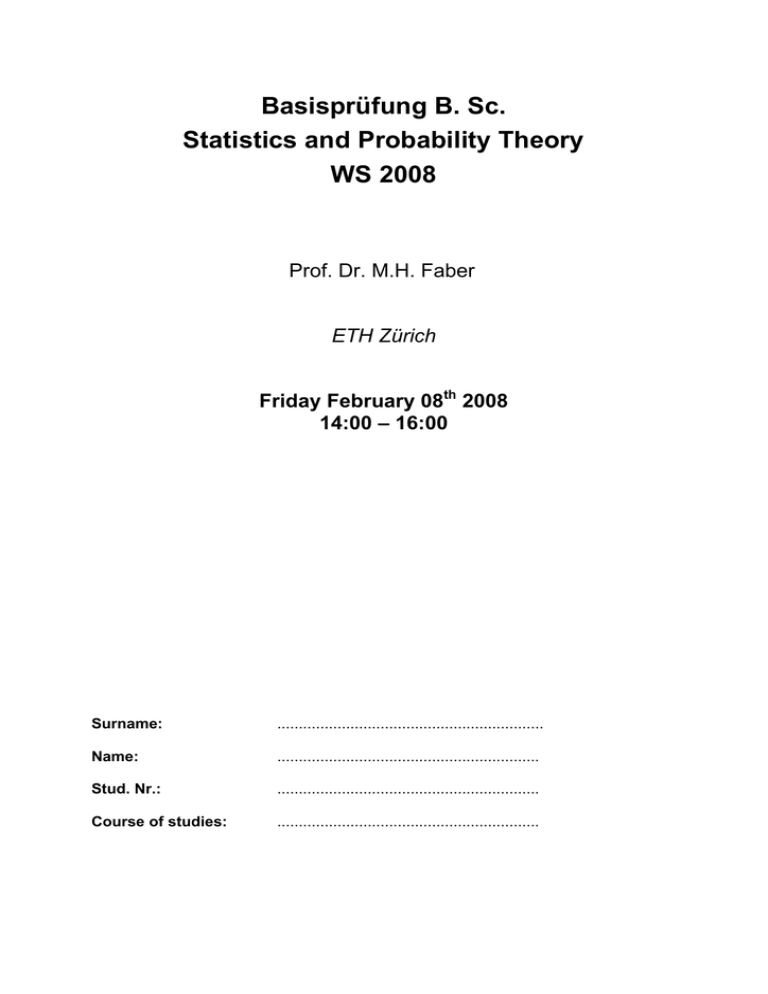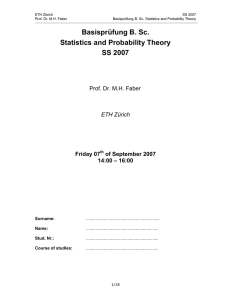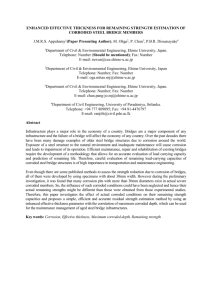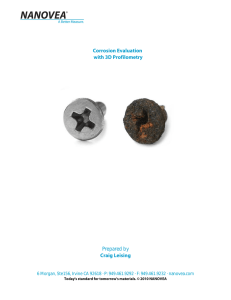Basisprüfung B. Sc. Statistics and Probability Theory WS 2008
advertisement

Basisprüfung B. Sc. Statistics and Probability Theory WS 2008 Prof. Dr. M.H. Faber ETH Zürich Friday February 08th 2008 14:00 – 16:00 Surname: .............................................................. Name: ............................................................. Stud. Nr.: ............................................................. Course of studies: ............................................................. ETH Zürich Prof. Dr. M.H. Faber WS 2008 Basisprüfung B. Sc. Statistics and Probability Theory Basisprüfung B. Sc.: Statistics and Probability Theory Civil, Environmental and Geomatic Engineering Date and duration: Friday February 08th 2008 Start: 14:00 Duration: 120 minutes Aids: - - All documentation and manuals allowed (Lecture notes, Exercise tutorials, other books and print-outs etc.) Calculators are allowed, but no communication medium (e.g. cell phones, calculators with Bluetooth etc.) Administration: - - - During the 15 minutes reading, it is not allowed to write on the solution sheets. Please place your Legi-card on your desk. Control first if you have received all the materials: o General information and exercises (16 pages) o 6 sheets of paper (checkered and stamped) Write your name on every sheet of paper. Use only the provided sheets of paper (6 checkered and officially stamped sheets) and use a new sheet for every exercise. Other sheets will not be considered in the corrections! When you have finished, place all materials in the envelope and leave it on your desk. You are allowed to leave the exam at any time until 15:45. After that time, you need to wait until the end of the exam. Content of the exam: Content Data Exercise 1 Exercise 2 Exercise 3 Exercise 4 Exercise 5 Exercise 6 Annexes Glossary Description Data on half-cell potential measurements Descriptive statistics Bayes’ theorem Probability paper Confidence interval and hypothesis testing Goodness of fit test for a distribution Estimation of parameters for a distribution Table A: Cumulative distribution function of the Standard Normal distribution Table B: Critical values of the KolmogorovSmirnov test English-German Page Points 4 6 7 10 11 13 20 20 20 20 25 15 14 - 15 - 16 - 120 Remarks: - All exercises 1 to 6 have to be solved. If you are having difficulties in a certain question but need a value/number in order to continue, then make an assumption, mark it as an assumption, and continue the calculations with that value. 2 ETH Zürich Prof. Dr. M.H. Faber WS 2008 Basisprüfung B. Sc. Statistics and Probability Theory Data Note: The following data will be the basis for the following exercises. Note although, that the exercises should be solved independently one from the other. The half-cell potential measurement test is an inspection technique commonly used to assess the presence of corrosion in reinforced concrete structures by measuring the electric potential [mV]. Table 1 contains the electric potentials measured by a half-cell potential measurement test for concrete elements with and without presence of corrosion in the reinforcement. The actual state of corrosion has been assessed by exposing the reinforcement after the potential measurements. Table 1: Measured potential values for concrete elements with and without the presence of corrosion in reinforcement (sorted). 1 2 3 4 5 6 7 8 9 10 11 12 13 14 15 16 17 No corrosion Potential [mV] -221 -201 -166 -146 -120 -118 -113 -86 -50 -5 3 Corrosion Potential [mV] -532 -455 -432 -373 -360 -337 -312 -280 -279 -260 -253 -250 -233 -210 -165 -163 -160 ETH Zürich Prof. Dr. M.H. Faber WS 2008 Basisprüfung B. Sc. Statistics and Probability Theory Exercise 1: Descriptive statistics (20 Points) A) Assess the sample size, the sample mean, the sample median and the sample standard deviation for the measured potential values for the concrete elements with the presence of corrosion in the reinforcement shown in Table 1 (right column) on page 3. Write your results in the following boxes. B) Draw the Tukey box plot in Figure 1 for the case when corrosion is present in the reinforcement, using the data given in Table 1 (right column) on page 3. Calculate the following values and indicate them in the plot: median, upper and lower quantiles, interquartile range, upper and lower adjacent values, and outside values (if there are no outside values, please remark it, too). 4 ETH Zürich Prof. Dr. M.H. Faber WS 2008 Basisprüfung B. Sc. Statistics and Probability Theory Figure 1: Tukey box plot. 5 ETH Zürich Prof. Dr. M.H. Faber WS 2008 Basisprüfung B. Sc. Statistics and Probability Theory Exercise 2: Bayes’ theorem (20 Points) The testing institute that carried out the half-cell potential measurements claims that a measurement of less than -200 [mV] indicates a state of corrosion of the reinforcement. Let C be the event that the reinforcement is in a true state of corrosion. Let I represent the event that the half cell potential measurement indicates a state of corrosion. I represents the complementary set. Table 2: Probability of indication from the half-cell potential measurements. True state of corrosion Indication from potential measurement I I C P( I C ) = P( I C ) = C P( I C ) = P( I C ) = A) Fill out Table 2 by using the data given in Table 1 (on page 3) and using the statement made by the testing institute. B) The half-cell potential measurement is now carried out to assess the probability of corrosion in another structure. From past experience, it is known that the probability of the reinforcement being in a state of corrosion is 5%. i) What is the probability that an indication from the half-cell potential measurement correctly corresponds to the true state of corrosion? ii) The half cell potential at a location in the structure is measured as -274 [mV]. What is the probability that the reinforcement is in a true state of corrosion? (Note: Part B ii) is independent of part B i)) 6 ETH Zürich Prof. Dr. M.H. Faber WS 2008 Basisprüfung B. Sc. Statistics and Probability Theory Exercise 3: Probability paper (20 Points) The cumulative distribution function for a shifted exponential distribution can be expressed as: FX ( x) = 1 − exp ( −λ ( x − ε ) ) , x ≥ ε, λ > 0 where λ and ε are the parameters of the distribution. The suitability of this distribution for the data in the left column of Table 1 (on page 3) is being investigated. A probability paper for the shifted exponential distribution needs to be constructed for this purpose. A) Define the vertical axis of the probability paper in Figure 2. B) The data from the left column of Table 1 (on page 3) has already been copied into the right column of Table 3. Fill out the second and third columns in Table 3. C) Scale the vertical axis of the probability paper in Figure 2 suitably corresponding to the number of observations in Table 3. D) Check if the data given in the left column of Table 1 can be represented by a shifted exponential distribution. Justify your answer suitably. 7 ETH Zürich Prof. Dr. M.H. Faber WS 2008 Basisprüfung B. Sc. Statistics and Probability Theory Table 3: Calculations for the construction of probability paper. Observation i i / (10 + 1) Vertical axis in Figure 2 Potential xi in [mV] (sorted) 1 -221 2 -201 3 -166 4 -146 5 -120 6 -118 7 -113 8 -86 9 -50 10 -5 8 ETH Zürich Prof. Dr. M.H. Faber WS 2008 Basisprüfung B. Sc. Statistics and Probability Theory Figure 2: Probability paper for the shifted exponential distribution. x -250 -200 -150 -100 9 -50 0 ETH Zürich Prof. Dr. M.H. Faber WS 2008 Basisprüfung B. Sc. Statistics and Probability Theory Exercise 4: Confidence interval and hypothesis testing (20 Points) A) It is known that the half-cell potential of not corroded samples can be modeled as a Normal distributed random variable X with standard deviation σ X = 60 [mV]. Based on the known standard deviation σ X and using the samples in the left column of Table 1, calculate the 90% confidence interval of the mean value of the random variable X . B) From the first testing institute, you have the measurement results given in Table 1. A second testing institute has been contracted for testing the same concrete elements with the half-cell potential measurements. The objective is to check whether the different devices used by the different institutes lead to a similar, or to a significantly different sample mean. The measurements from the first testing institute lead to a sample mean x1 = -122 [mV] with standard deviation sx1 = 65 [mV] for the not corroded elements. The measurements from the second testing institute lead to a sample mean x2 = -130 [mV] with standard deviation sx2 = 65 [mV] for the same not corroded elements. Can it be said, based on this data, that the mean of the half-cell potential for not corroded elements measured by the two devices is the same at the 5% significance level? Assume a Normal distribution for the data. C) Assuming the half-cell potential measurements of not corroded elements to be Normal distributed with mean value μ X = -125 [mV] and standard deviation σ X = 60 [mV], what is the probability that the potential measurement of a not corroded reinforced concrete element is less than -200 [mV]? 10 ETH Zürich Prof. Dr. M.H. Faber WS 2008 Basisprüfung B. Sc. Statistics and Probability Theory Exercise 5: Goodness of fit test for a distribution (25 Points) For the data in the left column of Table 1 (represented here in the first column of Table 4) showing the half-cell potential values measured for concrete elements without the presence of corrosion, the goodness of fit for a Normal distribution with parameters μ X = -150 [mV] and σ X = 40 [mV] shall be checked with a test. A) Fill out Table 4 completely. B) Carry out a Kolmogorov-Smirnov goodness of fit test to check at the 10% significance level, if the data of the potential values indicating no presence of corrosion can be represented by the above given Normal distribution. Table 4: Calculation sheet. Fo ( xio ) = i n Fo ( xio ) − Fp ( xio ) Fp ( xio ) i xi : Potential [mV] 1 -221 2 -201 3 -166 4 -146 5 -120 6 -118 7 -113 8 -86 9 -50 10 -5 11 ETH Zürich Prof. Dr. M.H. Faber WS 2008 Basisprüfung B. Sc. Statistics and Probability Theory C) An engineer has established two different models, model I and model II , for the half-cell potential measurement values of not corroded elements shown in Table 1 (left column). She now carries out a Kolmogorov-Smirnov test at the 10% significance level. She also calculates the sample likelihood for both models (see Table 5). Table 5: Sample likelihoods for the two models I and II . Model Sample statistic Sample likelihood I 0.331 0.402 II 0.356 0.275 1. Can the engineer accept at the 10% significance level the distribution described by model I and by model II being representative for the half cell potential measurement data in the left column of Table 1? Justify your answer. 2. Which one of the two models is more suitable for modeling the half cell potential measurement data in the left column of Table 1? Justify your answer. 12 ETH Zürich Prof. Dr. M.H. Faber WS 2008 Basisprüfung B. Sc. Statistics and Probability Theory Exercise 6: Estimation of parameters for a distribution (15 Points) To estimate the probability pc of corroded pillars of a reinforced structure, an engineering consulting company is contracted to carry out half-cell potential measurements. Out of 27 samples, 17 pillars are found to be corroded, and 10 pillars are found to be not corroded. What is the maximum likelihood estimate for pc ? A) Write down the likelihood function to be maximised. B) Estimate the parameter pc with the Maximum Likelihood Method, writing down the log-likelihood function, and maximizing the function for the parameter pc . Hint: Use the Binomial distribution. 13 ETH Zürich Prof. Dr. M.H. Faber WS 2008 Basisprüfung B. Sc. Statistics and Probability Theory Annex: Table A Cumulative distribution function of the Standard Normal distribution Φ ( z ) . 0 z Probability density function of the standard normal random variable. z z z z 14 z ETH Zürich Prof. Dr. M.H. Faber WS 2008 Basisprüfung B. Sc. Statistics and Probability Theory Annex: Table B Critical values of the Kolmogorov-Smirnov test. 15 ETH Zürich Prof. Dr. M.H. Faber WS 2008 Basisprüfung B. Sc. Statistics and Probability Theory Glossary Assumption Annahme Appropriate passend Column Spalte Contract Vertrag abschliessen Corrosion Korrosion Derive Herleiten aus Establish Aufstellen, errichten Exceed Überschreiten, grösser sein als Experience Erfahrung Half-cell potential measurement Potentialfeldmessung Pillar Pfeiler Postulate Postulieren, Vorschlagen Reinforced concrete Bewehrter Beton/Armierter Beton State Zustand Testing institute Testinstitut 16






